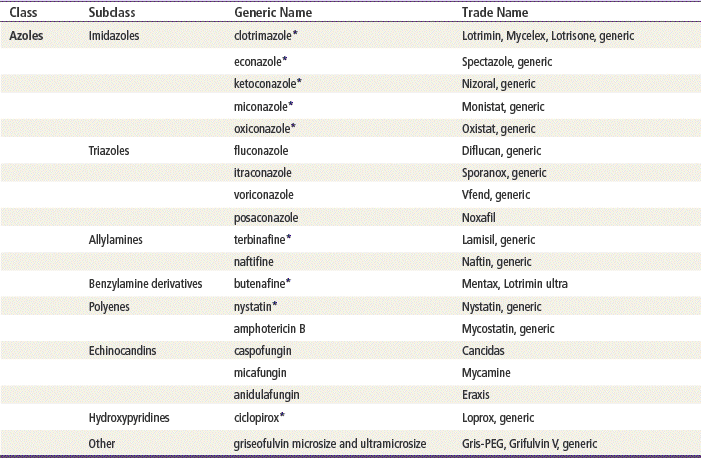http://evolve.elsevier.com/Edmunds/NP/
A growing number of antifungals are now available for topical or oral use. This chapter discusses the oral antifungals most commonly used in the primary care treatment of two types of fungal infection: (1) endemic fungal infection, such as blastomycosis, histoplasmosis, and sporotrichosis, and (2) superficial fungal infection not responsive to topical therapy. Fluconazole is commonly used for vulvovaginal candidiasis. Chapter 13 discusses the treatment of superficial fungal infections with topical antifungal agents. Several of the newer antifungals are administered parenterally and are used in specialty practice; these are not discussed here. Ketoconazole and itraconazole have “black box” warnings—itraconazole for CHF and 3A4 drug interactions, and ketoconazole for hepatotoxicity and 3A4 drug interactions.
All antifungals are associated with a significant risk of serious adverse reactions and should be used with caution. The azoles are synthetic compounds with broad antifungal activity that are effective against most yeast and filamentous fungi. Many new antifungals are available for the treatment of invasive aspergillosis and other serious fungal infections refractive to other therapy, particularly in patients with HIV; these are used primarily by dermatologists or other specialists and are not discussed in this chapter. Amphotericin B is an older drug that is not discussed in this text because it is used primarily by specialists for progressive and potentially fatal fungal infections.
Therapeutic Overview
Fungi can be divided into two broad categories based on morphology: yeasts and molds. Yeasts are unicellular fungi that are typically round or oval and reproduce by budding. When buds do not separate, they form long chains of yeast cells known as pseudohyphae. Molds are multicellular colonies that are composed of tubular structures called hyphae that grow by branching and longitudinal extension. Some fungi are dimorphic and can grow as either yeast or molds, depending on environmental conditions.
Fungal and mammalian cells are eukaryocytes. In contrast to bacteria, which are prokaryocytes, eukaryocytes have a distinct nucleus, specialized organelles, and a protective cell membrane. A key difference between fungal and mammalian cells is the sterol used in the synthesis of their respective cell membranes—ergosterol in fungi, and cholesterol in mammals.
Pathophysiology
Mycosis is the presence of parasitic fungi in or on the body. Most fungi that are pathogenic in humans grow as yeast, are nonmotile, and with rare exceptions are not transmissible. Fungal infections can be superficial (i.e., confined to the keratinous layers), subcutaneous, or deeply invasive.
Disease Process
Fungal infections have increased dramatically over the past 20 years. This increase is associated with the widespread use of broad-spectrum antibiotics, a rise in the number of invasive procedures, immunosuppression associated with organ transplants and chemotherapy, the treatment of autoimmune disorders, and HIV. The HIV epidemic has radically altered the spectrum and frequency of fungal infections. Fungal infections in transplant patients and those with HIV tend to be severe and usually require treatment for a prolonged period of time.
Topical Fungi
Fungal infections of the nails remain prevalent, and the demand for treatment has increased as safer drugs have been developed. A factor that limits this treatment is the refusal of many health insurance companies to reimburse for these medications, which are expensive and must be used for an extended period. Infections of the nails are generally impervious to superficial treatment. Ciclopirox (Penlac) is a new topical medication that is effective for skin and nail infections; however, it is expensive (see Chapter 13).
Some tinea infections require systemic treatment. Tinea capitis (most commonly caused by Trichophyton tonsurans) usually requires systemic treatment. Tinea corporis (usually caused by T. rubrum) usually responds to topical therapy but may require systemic treatment. Tinea versicolor is caused by Malassezia furfur (also known as Pityrosporum orbiculare) and frequently requires systemic treatment.
Candida albicans is part of the normal flora of the mouth, vagina, and feces of most people. Overgrowth of candida organisms causes mucosal candidiasis, which may affect the mouth, esophagus, and vulvovagina. It is also frequently found on the skin, especially in skin folds. Vulvovaginal candida is discussed in Chapter 58. Topical candida is discussed in Chapter 13. Risk factors for invasive candidiasis (i.e., fungemia and endocarditis) include neutropenia, recent surgery, broad-spectrum antibiotic therapy, indwelling catheters (IV or bladder), and immunodeficiency. HIV infection should be suspected if the patient has invasive candidiasis.
Endemic Mycoses
The primary care provider should be aware of endemic fungal infections in rural and regional populations and should maintain a high index of suspicion. Some types of diagnostic cytology, such as skin scraping smears, are inexpensive and are easily done in the outpatient setting. Most of these fungi do not result in systemic infection in immunocompetent persons. Individuals who are immunocompromised, especially those with HIV, are at higher risk for infection. Other groups at risk include infants, young children, and the elderly. Although many fungal species have been identified, only the most common are discussed here.
Endemic mycoses are fungi that cause disease in healthy hosts. Infection is caused by inhalation of the organism from the environment during the mold phase. The clinical presentation is generally a nonspecific or atypical pulmonary infection. Many fungi are associated with geographic regions, and these patterns assist clinicians in making a clinical diagnosis. However, because many individuals travel, this information has become less reliable. The severity of disease depends on the amount inhaled and the immune response of the patient.
Histoplasmosis is caused by Histoplasma capsulatum, which is prevalent in eastern and central United States. It can be found in bird droppings and bat exposure along river valleys, especially the Ohio and Mississippi River valleys. Locations with a large bat population and many flocks of birds are more likely to be affected. It is common to find human infection in these areas. Most cases are asymptomatic or mild and go unrecognized. More severe infections present as atypical pneumonia. Progressive disseminated infections can be severe and may be fatal. Severe symptoms include marked prostration, fever, dyspnea, and loss of weight.
Coccidioidomycosis is caused by Coccidioides immitis, a mold that grows in soil in arid regions of southwestern United States, Mexico, and Central and South America. Few immunocompetent people get these infections, but among those who do, chronic pulmonary disease or death may occur. Clinical findings include respiratory tract symptoms with fever, chills, and arthralgia.
Blastomycosis is caused by Blastomyces dermatitidis. It is endemic to the south-central states that border the Mississippi and Ohio River basins, southeastern and midwestern United States, and Canada. Infection occurs primarily in healthy individuals during occupational or recreational contact with soil from streams and rivers. Although many may be asymptomatic, disseminated infection can cause lesions on the lungs, skin, and bones, and in the urogenital system. Patients may have primarily cutaneous symptoms, including papules, nodules, or plaques.
Pneumocystosis is caused by Pneumocystis jiroveci. This fungus is found in the lungs of many domesticated and wild mammals and is distributed worldwide in humans. It seldom causes illness in immunocompetent people. It causes an acute pneumonia in premature or debilitated infants in hospitals and underdeveloped countries, as well as in older children and adults who have weakened cellular immune systems, most commonly HIV. It is a frequent cause of death in patients with AIDS.
Cryptococcosis is caused by Cryptococcus neoformans, a yeast that is found worldwide in soil and in dried pigeon dung. It is acquired by inhalation. Immunocompetent people rarely develop clinically apparent pneumonia. Progressive lung disease and dissemination occur in patients with immunodeficiency, including HIV.
Aspergillosis is caused by Aspergillus fumigatus. The fungus can be found in soil and decaying vegetation and may invade items of food and water. This fungus often colonizes in burn eschar and detritus in the external ear canal. Clinical symptoms include bronchospasm and pulmonary infiltrates. It can become invasive, again most commonly in patients who are immunocompromised, such as those with HIV.
Mechanism of Action
The azoles are primarily fungistatic rather than fungicidal. They are classified as imidazoles or triazoles, depending on whether the azole has two or three nitrogens in the five-membered azole ring.
The primary antifungal effect of the azoles is inhibition of ergosterol synthesis. This is accomplished by disrupting C-14 α-demethylase, an enzyme dependent on cytochrome P450. Without ergosterol, fungal cell membranes become more permeable and leak cell contents. Cell growth and replication are thereby inhibited.
Terbinafine blocks the biosynthesis of ergosterol, an essential component of fungal cell membranes.
Griseofulvin is derived from a species of Penicillium. It is deposited in the keratin of diseased tissue, making it resistant to fungal infection. The diseased tissue is gradually exfoliated and is replaced by noninfected tissue. See Table 67-1 for a comparison of the mechanisms of action of commonly used antifungals.
TABLE 67-1
Classification and Mechanism of Action of Selected Antifungal Antibiotics

| Class | Representative Drugs | Mechanism of Action and Antifungal Effects |
| Azoles | clotrimazole | Inhibition of fungal lanosterol 14-α demethylase, resulting in depletion of ergosterol and accumulation of toxic sterols in the fungal cell membrane; fungistatic |
| Triazoles | voriconazole | Candida: Time-dependent fungistatic Aspergillus: Time-dependent slow fungicidal |
| Polyenes | nystatin | Interaction with ergosterol, formation of aqueous channels, increased membrane permeability, and subsequent leakage of intracellular components; fungistatic and fungicidal properties |
| amphotericin B | Fungicidal | |
| Hydroxypyridine | ciclopirox | Inhibition of essential enzymes by creation of a large polyvalent cation through chelation, thus interfering with mitochondrial electron transport processes and energy production; fungicidal and fungistatic properties |
| Other antifungals | griseofulvin | Inhibition of fungal cell mitosis and nucleic acid synthesis and interference with the function of spindles and cytoplasmic microtubules by binding to α- and β-tubulin; fungistatic |
Modified from Zhang AY et al: Advances in topical and systemic antifungals, Dermatol Clin 25:165-183, 2007.
Treatment Principles
The Infectious Diseases Society of America has put forth guidelines for the treatment of patients with aspergillus, blastomycosis, coccidioidomycosis or cryptococcal disease, candidiasis, histoplasmosis, and sporotrichosis (www.idsociety.org).
Cardinal Points of Treatment
Stay updated, free articles. Join our Telegram channel

Full access? Get Clinical Tree



